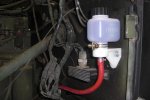rlwm211
Active member
- 1,648
- 19
- 38
- Location
- Guilford, NY
The plug on the hydraulic end of the air pack (small end) is where the brake pressure switch that operates in the fluid line would normally go. Your truck has the air switch upgrade for the brake lights. The air end is bigger.
The bleeder in pic 3 is to remove air from the air pack before bleeding the wheels.
As there are no leaks you are still on the hunt for the destination of the brake fluid you are losing. Be doubly sure you are not losing the fluid to a leak in your external resevoir system. I would hate to see you tear into a perfectly good airpack if it is actually something else that is leaking.
You could remove the remote resevoir and check the level in the master over a period of a few days and see if it is in fact a leak in the brake system or otherwise.
Also, as I recall, you had mentioned you were losing brake fluid without driving the truck. The only way you can lose that much fluid is by gravity helping out and I really doubt it is making it into the cannister on the air pack. Besides, if you had lost as much as you said, your air pack would be hydrolstatically locked by now and non-functional.
You mentioned you replaced the rear brakes, wheel cylinders etc, but did you service the fronts?
RL
The bleeder in pic 3 is to remove air from the air pack before bleeding the wheels.
As there are no leaks you are still on the hunt for the destination of the brake fluid you are losing. Be doubly sure you are not losing the fluid to a leak in your external resevoir system. I would hate to see you tear into a perfectly good airpack if it is actually something else that is leaking.
You could remove the remote resevoir and check the level in the master over a period of a few days and see if it is in fact a leak in the brake system or otherwise.
Also, as I recall, you had mentioned you were losing brake fluid without driving the truck. The only way you can lose that much fluid is by gravity helping out and I really doubt it is making it into the cannister on the air pack. Besides, if you had lost as much as you said, your air pack would be hydrolstatically locked by now and non-functional.
You mentioned you replaced the rear brakes, wheel cylinders etc, but did you service the fronts?
RL



